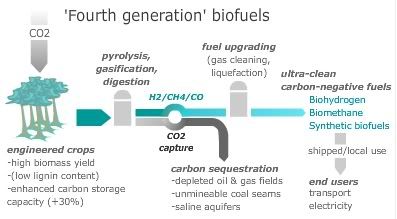Very good summary of the four generations - I'll summarise some of the 4th gen. points here:
- biomass crops are seen as efficient 'carbon capturing' machines that take CO2 out of the atmosphere and lock it up in their branches, trunks and leaves. The carbon-rich biomass is then converted into fuel and gases by means of second generation techniques.
- The resulting fuels and gases are not only renewable, they are also effectively carbon-negative (whereas 3rd gen. are carbon-neutral).
- For example, two teams of scientists recently announced they have succeeded in designing trees that store significantly more carbon dioxide than their ordinary counter parts. The feat has been achieved for eucalyptus, a prime biomass crop suitable for cultivation in the tropics
The question is what to use as biomass? The eucalyptus trees sound marvellous, but they're only suitable in the tropics. If we're looking for a Scottish solution, ideally we'd like biomass that can be grown in Scotland if 4th gen is going to be as 'carbon-negative' as it says it could be.
This is in addition to the low yield of 4th gen. mentioned in earlier posts.
Reference
Biopact

This comment has been removed by the author.
ReplyDeletePosted by Christopher Sanderson
ReplyDeleteAbove comment is mine, posted the url with a spelling error so deleted to avoid confusion.
Found this, grows in Siberia and Mongolia so will be fine in Scotland:
http://news.mongabay.com/bioenergy/2007/10/japanese-scientists-develop-hybrid.html
Posted by Stella Kin
ReplyDeleteNice find. I guess we'll have to address the issue of introducing a new species of tree into Scotland, but then any kind of farming on the scale we need is going to be controversial.
From Wikipedia:
"Dahurian Larch is occasionally grown in botanical gardens in Europe and North America; it is not an easy tree to grow in areas with mild winters as it is adapted to a long period of winter rest; the warm winter weather in Britain can tempt it into leaf as early as the start of January, with the tender young leaves then being killed by the next frost. In its native region, daily minimum temperatures above freezing do not occur until late May or June, with no further frost until the brief summer is over."
http://en.wikipedia.org/wiki/Larix_gmelinii
Questions: will it really thrive in Scotland - Relatively speaking, don't we have 'mild' winters? Hakkaido also have the advantage that the forests are already in place - I couldn't find immediately how long it will take for the trees to reach their full height (10m), but waiting might set us back a bit.
I hadn't thought of this aspect before, and even if we apply GM to local trees, we'd still have to wait for them to grow as well, hmm...?? Anyway, it's great you found this Chris, more to think about.
Btw, I in case you aren't aware, when you delete a comment, there is an option to delete it forever, and you can do so retrospectively by clicking on the trash can again. I'll leave it for now though so you see comment.